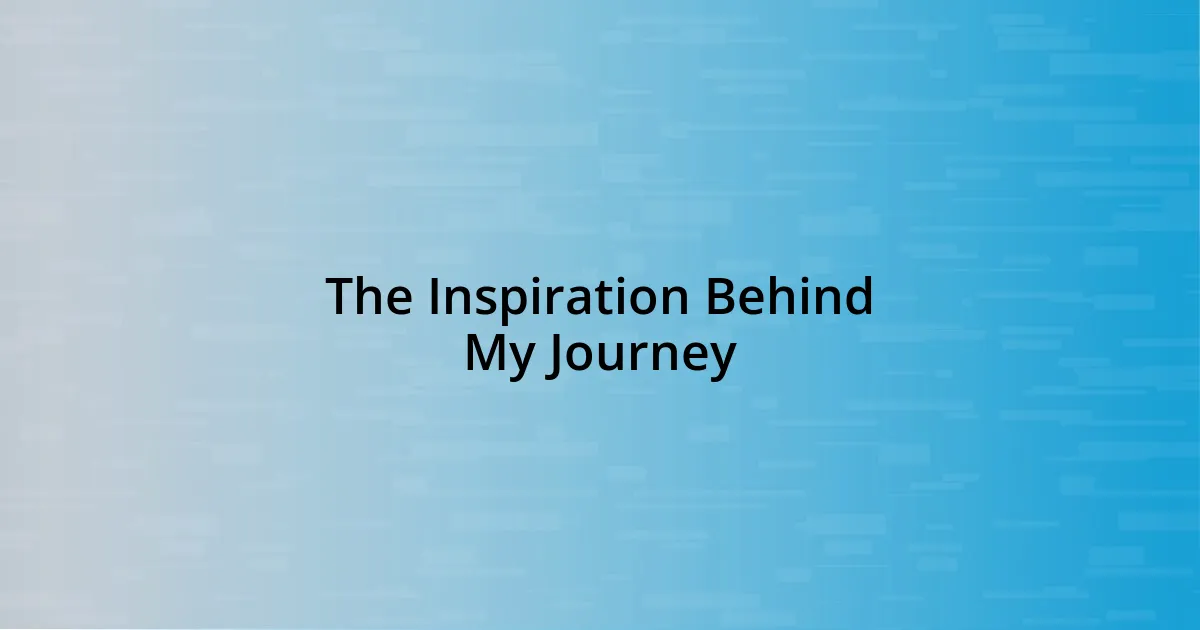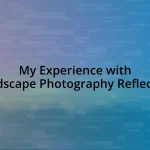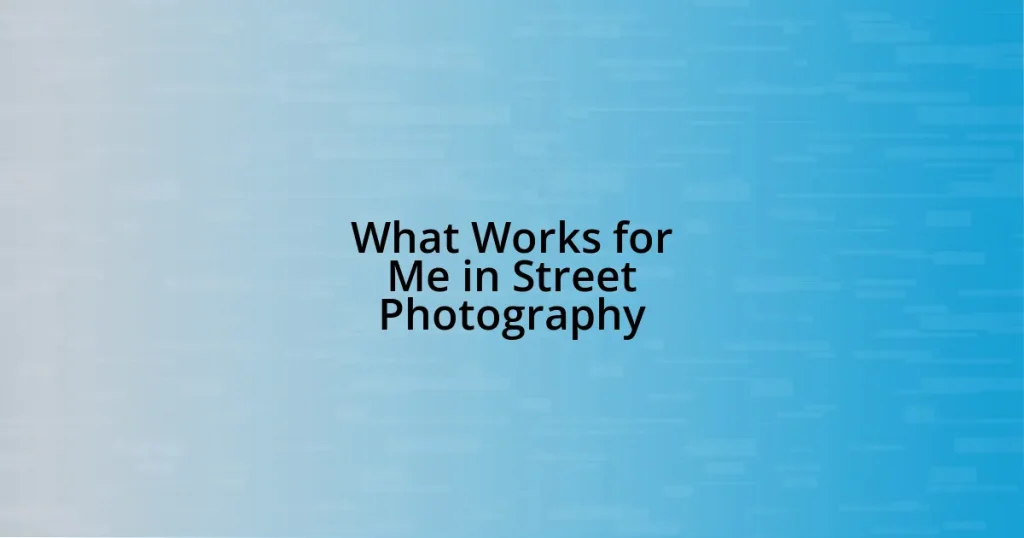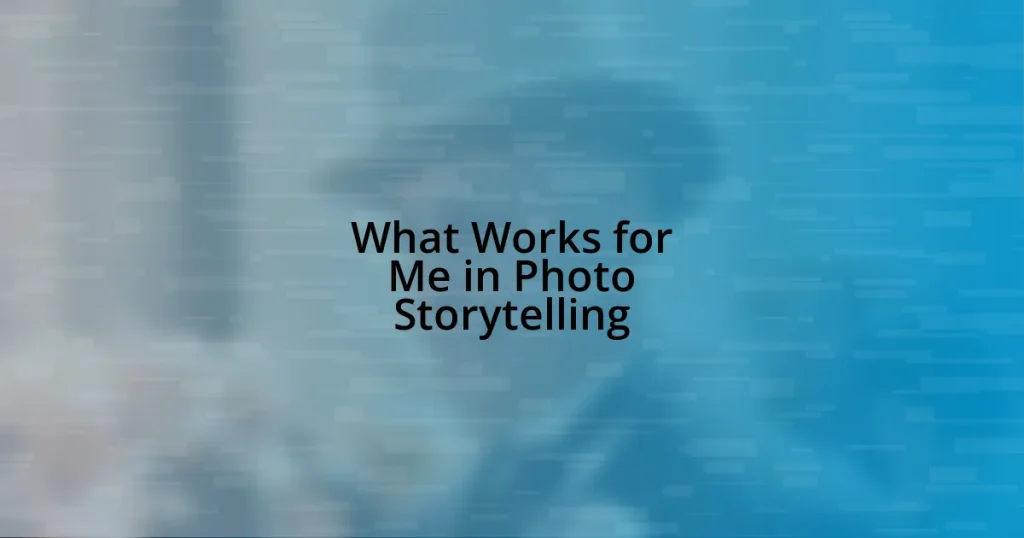Key takeaways:
- Minimalist photography emphasizes stripping away distractions to focus on the essence and emotions of the subject.
- The journey into minimalist photography often begins with a personal quest for clarity and simplicity in both art and life.
- Essential gear for minimalist photography includes a compact camera, a prime lens, and a light tripod, promoting a simplified shooting experience.
- Building a minimalist portfolio requires careful selection of images that resonate emotionally and maintain consistency in style to convey a cohesive story.

Understanding Minimalist Photography
Minimalist photography is all about stripping away the unnecessary to highlight the essence of a subject. I still remember the first time I took a photo where I consciously removed distractions. I aimed for a single flower against a stark background, and the impact was profound. It taught me that sometimes, less truly is more.
When I capture images with a minimalist approach, I often find myself asking, “What do I want the viewer to feel?” This question guides my composition and helps me distill my emotions into the frame. It’s fascinating how a clean, uncluttered image can convey strong feelings—like solitude or tranquility—without a single word.
As I delve deeper into this art form, I realize that minimalist photography can be a reflection of one’s personal journey. For me, it started as a quest to simplify my visual storytelling, but it evolved into a way to embrace clarity in my life. Each image becomes a form of meditation, inviting both me and the viewer to pause and breathe. Isn’t it remarkable how visuals can evoke such introspection?

The Inspiration Behind My Journey
The inspiration for my journey into minimalist photography stems from a moment of overwhelming clutter in my life. I recall sitting in my room surrounded by countless items that no longer served me. It struck me that each physical object distracted not only my space but my mind as well. This realization pushed me to seek clarity in my photography, leading me to experiment with capturing the world in simpler forms.
On one particularly serene evening, while walking through a quiet park, I stumbled upon a single leaf floating on the surface of a pond. The stillness and beauty of that moment compelled me to capture it, removing all other distractions from the frame. That image served as a reminder of how simplicity can be striking and evocative—something I now chase with each click of the shutter. It’s interesting how nature can teach us the power of minimalism, isn’t it?
Throughout this journey, I’ve discovered that minimalist photography is not just about the subjects but also about the emotions they ignite. I remember one photo of a lone tree against a sunset that stirred something profound within me. It spoke of resilience and solitude, conveying feelings with subtlety and depth. This exploration has transformed how I view the world, prompting me to focus on the essentials in both my art and my life.
| Inspiration Source | Emotional Insight |
|---|---|
| Cluttered Room | Clarity in Mind and Art |
| Single Leaf on Pond | Beauty in Simplicity |
| Lone Tree at Sunset | Resilience and Solitude |

Essential Gear for Minimalist Photography
When I first embraced minimalist photography, I discovered that the right gear is essential yet surprisingly simple. My experience has taught me that less truly is more, particularly when it comes to the equipment I carry. A lightweight camera and a versatile lens became my best friends, allowing me to quickly adapt to different environments without feeling bogged down.
Here’s a quick list of essential gear for minimalist photography:
- Mirrorless Camera: Compact and lightweight, perfect for on-the-go shooting.
- Prime Lens (35mm or 50mm): These lenses provide sharp images while encouraging you to move and explore your composition.
- Tripod: A small, sturdy tripod gives you stability, especially during low-light conditions, without taking up much space.
- Neutral Density Filter: This tool allows you to control brightness and experiment with long exposures, enhancing your minimalist images.
- Camera Bag: A minimalistic bag that carries your gear without excessive clutter—think practicality and style.
I vividly remember using just my mirrorless camera and a prime lens during a weekend trip to the coast. The simplicity of my setup allowed me to focus on each scene without distractions. I aimed for shots of solitary rocks against crashing waves, capturing the raw beauty of nature stripped down to its essence. That experience reinforced my belief that in minimalist photography, the gear should empower your vision rather than constrain it.

Techniques for Capturing Minimalism
When it comes to techniques for capturing minimalism, I’ve found that intentionally simplifying your composition is key. I often ask myself what elements are truly necessary in the frame. For instance, during a quiet afternoon in my backyard, I captured a single flower against a blurred green background. This shot taught me that eliminating distractions can transform an ordinary subject into something extraordinary, inviting the viewer to appreciate the subtle beauty of simplicity.
Another technique I’ve embraced is playing with negative space. I distinctly remember photographing a lonely bench in an empty park, surrounded by vast stretches of grass. In that image, the emptiness spoke volumes, conveying feelings of solitude and introspection. It made me wonder—how often do we overlook the impact of space in our compositions? The interplay between subject and background can evoke strong emotions, emphasizing the power of what’s absent as much as what’s present.
Lighting is another critical aspect I’ve learned to master in minimalist photography. Natural light can create a magical atmosphere, especially during golden hour. Once, I was captivated by the way soft sunlight illuminated a weathered door, casting delicate shadows that added depth without clutter. Each ray seemed to highlight the door’s character, prompting me to think about how lighting can enhance the essence of a subject while maintaining a minimalist approach. Isn’t it fascinating how a simple change in light can completely alter the mood and message of a photograph?

Post-Processing Tips for Minimalist Images
When it comes to post-processing minimalist images, subtlety is everything. I’ve learned that less is often more; a slight tweak in exposure or contrast can create an impactful change without overwhelming the image. Just the other day, I took a photo of a solitary boat on a still lake at sunset. By adjusting the saturation just a notch, I was able to enhance the serene colors while preserving the tranquility of the scene.
I often find it’s tempting to apply heavy filters or effects, but embracing a more restrained approach has served my minimalist style well. For example, I processed an image of a single tree against a stark winter sky by reducing distractions in the background and focusing on the texture of the branches. It struck me how clarity in editing can emphasize the beauty in simplicity, drawing the viewer’s attention to the narrative within the frame. Isn’t it amazing how clarity can breathe life into an image?
Lastly, I believe that cropping is a powerful tool in post-processing for minimalist photography. I remember capturing a lone figure walking along an empty beach. In the editing phase, I cropped tightly to eliminate unnecessary elements and center the viewer’s focus on the person’s journey against the vastness of the ocean. This choice allowed the viewer to feel that isolation and reflection. How do you approach cropping in your own work? I encourage you to experiment—sometimes, a simple trim can reveal the essence you never knew existed in your photograph.

Building a Minimalist Portfolio
Building a minimalist portfolio requires a keen sense of selection. I remember sifting through my images one day and realizing that out of the thousands I’ve shot, a handful truly resonated with me. These weren’t just pretty pictures; they were reflections of my journey toward embracing simplicity. Selecting only pieces that genuinely represent my vision has helped cultivate a focused and impactful portfolio, creating a cohesive story that speaks louder than endless options.
As I crafted my portfolio, I often asked myself: what emotions do these images evoke? Picking the right visuals isn’t just about aesthetics; it’s about conveying feelings. I decided to include a few stark black-and-white images that showcase emotion, like a solitary figure gazing out at a misty horizon. The absence of color forces the viewer to engage more deeply with the subject, sparking contemplation on their own experiences. Have you ever considered how a monochrome palette can sharpen the narrative you wish to tell?
I find that consistency in style can elevate a minimalist portfolio significantly. While reviewing my work, I aimed to maintain a similar tone and atmosphere across my images—there’s something captivating about a harmonized collection. For example, the soft neutrals and calm scenes of a recent series on coastal lines create a soothing visual rhythm. This intentionality allows viewers to immerse themselves fully, almost as if they’re walking through a gallery that tells a single, powerful story. Isn’t it remarkable how a focused approach can transform the perception of a diverse set of photographs into a unified masterpiece?

Overcoming Challenges in Minimalist Photography
Navigating the challenges of minimalist photography can be daunting, especially when you’re fighting against a cluttered world vying for your attention. I once set out to capture a bustling city street, but when I reviewed my images, I felt overwhelmed by the chaos. To overcome this, I learned to consciously seek out simpler subjects amidst the noise, honing in on clean lines and minimal details that tell a story more effectively. Have you experienced this disconnect between intention and outcome in your own shooting?
Another significant hurdle I’ve encountered is the temptation to fill an empty space with too much visual noise. I recall struggling with a shot of a barren landscape, debating whether to include a few scattered rocks to add interest. Ultimately, I chose to leave the frame open, and it was liberating. The negative space became just as compelling, inviting the viewer to breathe and reflect on the vastness. Isn’t it fascinating how what we initially perceive as a flaw can transform into an asset?
I’ve also faced moments where inspiration seemed elusive. During a creative block, I challenged myself to go out with just one lens, forcing my perspective to narrow in on the essentials. This limitation sparked my creativity, prompting me to look for patterns and shapes I would have otherwise overlooked. Have you ever tried restricting your tools to discover new avenues of expression in your work? The experience taught me that sometimes, less truly can lead to more—an unexpected but rewarding discovery on my photographic journey.
















